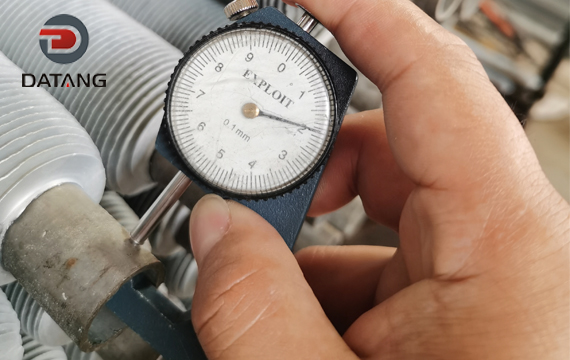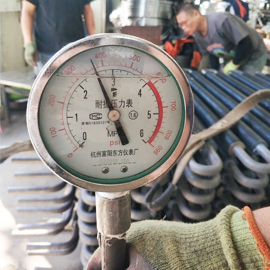When purchasing extruded fin tubes, it’s important to consider multiple factors, including material, craftsmanship, operating environment, and after-sales service, to ensure you’re purchasing a suitable and durable product.
Extruded Fin Tube Inspection
Appearance and Structural Inspection
Visually inspect the fins for flatness, deformation, collapse, or damage, and for cracks or leaks in the tubing.
Measure the fin spacing to ensure uniformity (with a deviation of no more than ±0.2mm).

Performance Testing
Pressure Test: Tests the seal and pressure resistance under operating pressure.
Heat Exchange Efficiency Test: Measure the inlet and outlet fluid temperature difference under rated operating conditions to evaluate heat exchange performance.
Pressure Drop Test: Measure the pressure loss during refrigerant or fluid flow. Excessive pressure drop may indicate a blockage or structural abnormality.

Material and Corrosion Resistance
Inspect the base tube and fin materials to ensure they meet design requirements (e.g., 304/316 stainless steel). Evaluate corrosion resistance and metal fatigue strength.
Cleanliness and Sealing
Inspect the fins and tubing for dirt, dust, or sediment. Clean if necessary.
Leak Test: After pressurization, inspect the joints and tubing for leaks and ensure there are no bubbles or leaks.
Special Testing (Optional)
Ultrasonic Testing: Detects internal defects and weld quality (e.g., metallurgical bond strength during high-frequency welding).
Infrared Thermal Imaging: Scans the temperature distribution on the fin surface to identify abnormal hot spots or clogged areas.
During testing, ensure that all test parameters meet design standards. For example, the leak-proof seal test pressure can reach 1.5 MPa and be maintained at this pressure for 30 minutes.
I. Focus on Core Purchasing Factors
Material Selection: Select the appropriate material based on the properties of the medium within the tube (e.g., whether it is corrosive) and the actual operating conditions. Common materials include stainless steel (e.g., 304 stainless steel, which offers excellent corrosion resistance), carbon steel, and copper-aluminum composites.
1. In high-temperature or corrosive environments, stainless steel, which offers superior heat and corrosion resistance, should be preferred.
2. Craftsmanship and Quality: High-quality extruded finned tubes should have a smooth, even joint between the fin and the base tube, free of burrs or noticeable gaps, and no looseness.
3. You can request a third-party performance test report provided by the manufacturer, focusing on key data such as weld strength, pressure resistance, and heat dissipation coefficient.
4. Weighing the plate provides a preliminary assessment of whether the thickness meets the standard, thus avoiding products that cut corners.
II. Considering actual usage requirements
Operating parameter matching: The appropriate fin type (e.g., spiral, high-frequency welded, etc.) and specifications should be selected based on the actual heat exchange operating parameters (such as temperature, pressure, and fluid properties).
For example, aluminum finned tubes may not be suitable for hot fluid temperatures exceeding 300°C.
Environmental adaptability: If the fluid is dusty or contaminated, consider installing a filter or choosing an easily cleanable finned tube structure to prevent clogging that could affect heat exchange efficiency.
III. Pay attention to after-sales service and warranty
When purchasing, be sure to confirm whether the merchant provides a purchase contract. The contract should clearly include pressure testing and warranty terms to protect your rights.
IV. Other Considerations
Customization Requirements: If you require non-standard dimensions or special performance, you should contact the manufacturer in advance to confirm their production capacity and lead time.
Pricing and Promotions: While paying attention to price, be wary of excessively low prices and be aware of promotions. However, the final decision should be based primarily on product quality and actual needs.


